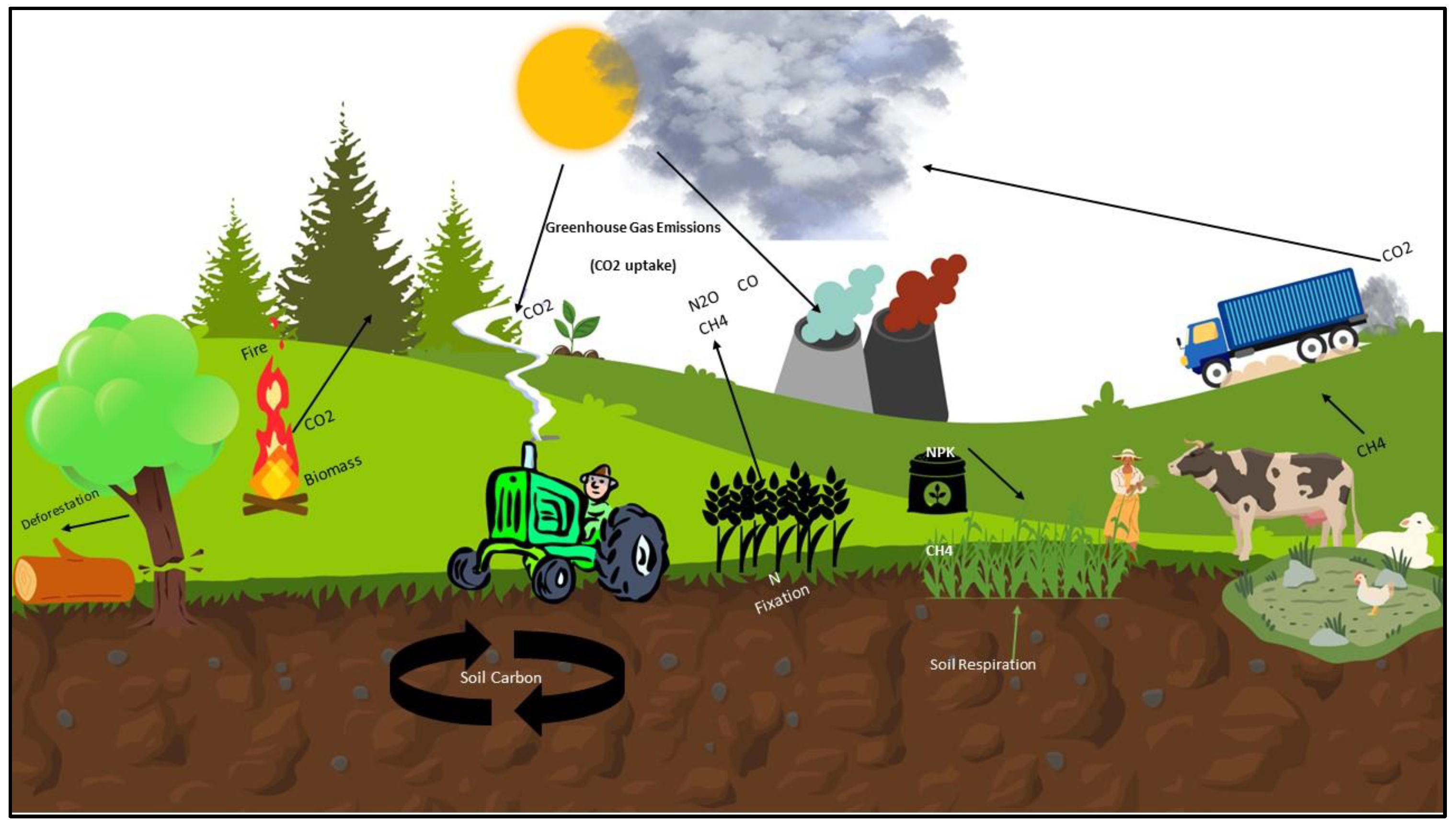The Importance of Variable Rate Irrigation in Lowering Greenhouse Gas Emissions in the Agriculture Sector: A Review †
Abstract
1. Introduction
2. Greenhouse Gas Emissions in Agriculture Sector
3. Role of VRI in lowering GHG Emissions
4. Conclusion
Author Contributions
Funding
Institutional Review Board Statement
Informed Consent Statement
Data Availability Statement
Acknowledgments
Conflicts of Interest
References
- Montzka, S.A.; Dlugokencky, E.J.; Butler, J.H.J.N. Non-CO2 greenhouse gases and climate change. Nature 2011, 476, 43–50. [Google Scholar] [CrossRef] [PubMed]
- Iqbala, M.M.; Akramb, M.M.; Ahmada, M.; Hussainc, S.; Usmana, G.J.B.D.I.W.R.E. Regional Climatic Response To Global Warming And Agriculture In Pakistan. Big Data Water Resour. Eng. (BDWR) 2021, 2, 18–23. [Google Scholar] [CrossRef]
- MacLeod, M.; Eory, V.; Gruère, G.; Lankoski, J. Cost-effectiveness of greenhouse gas mitigation measures for agriculture: A literature review. In OECD Food, Agriculture and Fisheries Papers; OECD: Paris, France, 2015. [Google Scholar]
- Waqas, M.S.; Cheema, M.J.M.; Hussain, S.; Ullah, M.K.; Iqbal, M.M.J.A.W.M. Delayed irrigation: An approach to enhance crop water productivity and to investigate its effects on potato yield and growth parameters. Agric. Water Manag. 2021, 245, 106576. [Google Scholar] [CrossRef]
- Kumar, A.; Nayak, A.; Mohanty, S.; Das, B.J.A. Greenhouse gas emission from direct seeded paddy fields under different soil water potentials in Eastern India. Agric. Ecosyst. Environ. 2016, 228, 111–123. [Google Scholar] [CrossRef]
- Aslam, M.; Arshad, M.; Hussain, S.; Usman, M.; Zahid, M.B.; Sattar, J.; Arshad, A.; Iqbal, M.M.; Waqas, M.S.J.P.J.A.S. An integrated approach for estimation of van genuchten model parameters in undisturbed and unsaturated soils. Pak. J. Agri. Sci. 2021, 58, 1887–1893. [Google Scholar]
- Rizvi, F.F.; Ahmed, B.; Hussain, S.; Khan, A.; Raza, M.; Shahid, M.J.I.J.o.G.W. Assessment of climate extremes from historical data (1960-2013) of Soan River Basin in Pakistan. Int. J. Glob. Warm. 2021, 25, 1–37. [Google Scholar] [CrossRef]
- Afroj, M.; Kazal, M.M.H.; Rahman, M.M. Precision agriculture in the World and its prospect in Bangladesh. Res. Agric. Livest. Fish. 2016, 3, 1–14. [Google Scholar] [CrossRef]
- Andrews, H.M.; Homyak, P.M.; Oikawa, P.Y.; Wang, J.; Jenerette, G.D.J.A. Water-conscious management strategies reduce per-yield irrigation and soil emissions of CO2, N2O, and NO in high-temperature forage cropping systems. Agric. Ecosyst. Environ. 2022, 332, 107944. [Google Scholar] [CrossRef]
- Arora, N.K.; Mishra, I.J.E.S. Current scenario and future directions for sustainable development goal 2: A roadmap to zero hunger. Environ. Sustain. 2022, 5, 1–5. [Google Scholar] [CrossRef]
- Aziz, S.; Chowdhury, S.A.J.E. Analysis of agricultural greenhouse gas emissions using the STIRPAT model: A case study of Bangladesh. Environ. Dev. Sustain. 2022, 1–21. [Google Scholar] [CrossRef] [PubMed]
- Cheng, H.; Shu, K.; Zhu, T.; Wang, L.; Liu, X.; Cai, W.; Qi, Z.; Feng, S.J.J.o.C.P. Effects of alternate wetting and drying irrigation on yield, water and nitrogen use, and greenhouse gas emissions in rice paddy fields. J. Clean. Prod. 2022, 349, 131487. [Google Scholar] [CrossRef]
- Dilawar, A.; Chen, B.; Ashraf, A.; Alphonse, K.; Hussain, Y.; Ali, S.; Jinghong, J.; Shafeeque, M.; Boyang, S.; Sun, X.; et al. Development of a GIS based hazard, exposure, and vulnerability analyzing method for monitoring drought risk at Karachi, Pakistan. Geomat. Nat. Hazards Risk 2022, 13, 1700–1720. [Google Scholar] [CrossRef]
- Mehmood, F.; Wang, G.; Gao, Y.; Liang, Y.; Zain, M.; Rahman, S.U.; Duan, A.J.W. Impacts of irrigation managements on soil CO2 emission and soil CH4 uptake of winter wheat field in the North China plain. Water 2021, 13, 2052. [Google Scholar] [CrossRef]
- Waqas, M.S.; Cheema, M.J.M.; Waqas, A.; Hussain, S. Enhancing water productivity of potato (Solanum tuberosum L.) through drip irrigation system. In Proceedings of the 2nd International Conference on Horticultural Sciences, Faisalabad, Pakistan, 16–18 February 2016; pp. 18–20. [Google Scholar]

Disclaimer/Publisher’s Note: The statements, opinions and data contained in all publications are solely those of the individual author(s) and contributor(s) and not of MDPI and/or the editor(s). MDPI and/or the editor(s) disclaim responsibility for any injury to people or property resulting from any ideas, methods, instructions or products referred to in the content. |
© 2023 by the authors. Licensee MDPI, Basel, Switzerland. This article is an open access article distributed under the terms and conditions of the Creative Commons Attribution (CC BY) license (https://creativecommons.org/licenses/by/4.0/).
Share and Cite
Hussain, S.; Cheema, M.J.M.; Waqas, M.S.; Saleem, S.R.; Rustam, R.; Khan, M.S.; Ullah, M.H. The Importance of Variable Rate Irrigation in Lowering Greenhouse Gas Emissions in the Agriculture Sector: A Review. Environ. Sci. Proc. 2022, 23, 35. https://doi.org/10.3390/environsciproc2022023035
Hussain S, Cheema MJM, Waqas MS, Saleem SR, Rustam R, Khan MS, Ullah MH. The Importance of Variable Rate Irrigation in Lowering Greenhouse Gas Emissions in the Agriculture Sector: A Review. Environmental Sciences Proceedings. 2022; 23(1):35. https://doi.org/10.3390/environsciproc2022023035
Chicago/Turabian StyleHussain, Saddam, Muhammad Jehanzeb Masud Cheema, Muhammad Sohail Waqas, Shoaib Rashid Saleem, Rameela Rustam, Muhammad Saadullah Khan, and Muhammad Habib Ullah. 2022. "The Importance of Variable Rate Irrigation in Lowering Greenhouse Gas Emissions in the Agriculture Sector: A Review" Environmental Sciences Proceedings 23, no. 1: 35. https://doi.org/10.3390/environsciproc2022023035
APA StyleHussain, S., Cheema, M. J. M., Waqas, M. S., Saleem, S. R., Rustam, R., Khan, M. S., & Ullah, M. H. (2022). The Importance of Variable Rate Irrigation in Lowering Greenhouse Gas Emissions in the Agriculture Sector: A Review. Environmental Sciences Proceedings, 23(1), 35. https://doi.org/10.3390/environsciproc2022023035









